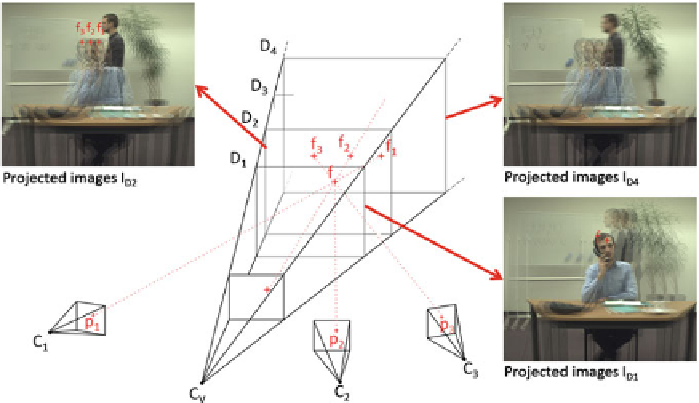Graphics Reference
In-Depth Information
Fig. 6.4
Plane sweeping conceptually: deprojecting real cameras
C
i
(
i
=
1
...
3) on different depth
planes
D
i
for virtual camera
C
v
causes a nonfocused ghosting artifact, depending on whether or
not the scene object in question is present at depth
D
i
Any voxel
f
in 3D space at, e.g., depth plane
D
1
is projected onto the 2D pixels
p
i
on the image plane of the respective camera views. Conversely, inversely projecting
(i.e., deprojecting) the pixels
p
i
into 3D space will have them match at one single
voxel
f
at the corresponding depth plane
D
1
. On all other depth planes
D
j
(
j
1)
the pixels
p
i
deproject on points
f
i
that do not coincide, as illustrated on depth
plane
D
2
. Visually, reprojecting these points
f
i
back into the virtual camera view
C
v
causes a nonfocused ghosting artifact in the resulting image, as can be observed in
the projected images
I
D
2
.
For instance, for the two-person scene of Fig.
6.4
, the person answering the phone
at the desk in the foreground is in focus at depth
D
1
(as can be seen in the projected
images
I
D
1
), whereas the person walking by in the background is out of focus at the
same hypothesized depth
D
1
. The background person in turn is in focus on depth
plane
D
2
(as can be seen in the projected images
I
D
2
), hence suggesting that his
corresponding voxels are indeed at depth
D
2
. Looking even deeper into the scene, the
whiteboard in the far background is de- and reprojected in focus at its corresponding
depth plane, say
D
4
, and is now in fact readable (projected images
I
D
4
).
=
6.3 A System Prototype
We present a fully functional prototype that corrects the eye gaze of the videoconfer-
encing peers by using multiple cameras, using the plane sweeping method reviewed
in the previous section. The proposed sixfold camera setup is easily integrated into
the monitor frame of Fig.
6.1
[
7
,
8
].

